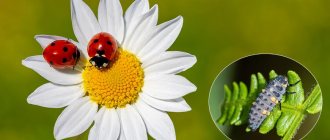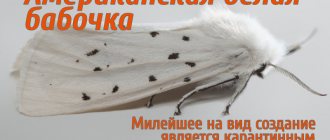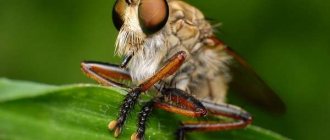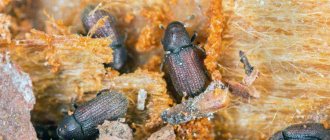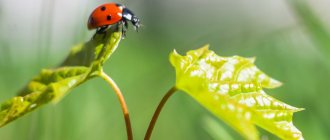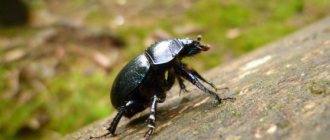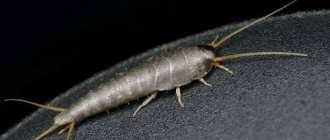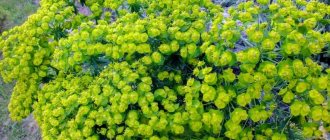Predatory insects eat other insects, called prey, and are quite active because they have to chase their prey. Carnivorous insects feed on many harmful arthropods and are an important part of the biome. The most common insect predators are the beetle, wasp and dragonfly families, as well as some flies such as the flower fly. Other arthropods, such as spiders, are also important predators of insect pests. Some predators feed on only one or a few types of prey, but most hunt a variety of insects and sometimes even each other.
Seven-spotted ladybird
The pronotum of the cow is black with large white spots on the sides. There are seven black spots in total, three on each wing cover and one central spot at the base of the pronotum.
Common lacewing
Adults have long slender bodies, antennae and two pairs of large wings with a reticulate vein. They pierce the victim with large sickle-shaped jaws and feed on biological fluids.
Hoverfly
Preys primarily on aphids and is an important natural regulator of aphid populations (garden pests). Adult hoverflies imitate bees, bumblebees, wasps and sawflies.
Krasotel fragrant
It is nocturnal and hides under logs, rocks or in soil crevices during the day. Runs away quickly when in danger. Can fly, but rarely does so. Attracted by light at night.
Common earwig
It is nocturnal, spending the day under leaves, in cracks and crevices and other dark places. Depends on the weather. A stable, minimally high temperature stimulates activity.
Ant
Black or brown ants are easily recognized by their narrow waists, bulbous abdomens, and ulnar antennae. Most of the time when you watch them, you see workers, all of them are females.
Jumping spider
Easily distinguished by the four large and four smaller eyes on the top of the head. Excellent vision allows them to hunt in the same way as cats, spotting prey at long distances by sneaking and jumping.
Garden ground beetle
Lives in eurytopic forests, found in open areas. Active at night and hunts earthworms, etc. on the forest floor. Recognizable by rows of golden indentations on the wings.
Ground beetle
They fly in May–June and are active at temperatures from 20 to 26°C. When it is above 36°C, they die. During drought, they burrow into the ground to a depth of 40 cm, resuming activity after rains and when the temperature drops.
Dragonfly
They catch prey by grabbing it with their paws. The main food is mosquitoes. The effectiveness of hunting has been proven by a study from Harvard University. Dragonflies caught 90 to 95% of the insects released into the vivarium.
Mantis
Uses pointed front paws to catch live insects. When an alarmed mantis takes on a “threatening” appearance, it raises and rustles its wings and displays warning coloration.
Grasshopper green
Lives in trees and meadows dotted with bushes, eats vegetation and other insects. Females lay eggs in dry soils and use long, curved ovipositors.
Wasp
The mouth parts and antennae have 12-13 segments. Wasps are predatory parasites, they have a sting that is easily removed from the victim, with a small number of barbs. A narrow “waist” attaches the belly to the ribcage.
Bug
They attack unwanted plants and feed on eggs, larvae and adult harmful insects. Bugs biologically control weeds and pest insect populations.
Water strider bug
They run in groups along ponds and streams. The bodies are thin, dark, more than 5 mm long. They use their short front legs to catch insects and eat them on the surface of the water. When there is little food, they eat each other.
Rider
The beneficial arthropod feeds on the eggs, larvae, and sometimes pupae of many insects, including aphids, caterpillars, butterflies, sawflies, leaf pliers, bugs, aphids, and flies.
Fly-ktyr
Known for its predatory behavior and appetite, it feeds on a huge number of arthropods: wasps, bees, dragonflies, grasshoppers, flies and spiders. Maintains insect population balance.
Scolopendra
The voracious predator feeds on invertebrates such as crickets, worms, snails and cockroaches, and also preys on lizards, toads and mice. This is a favorite insect for entomologists' vivariums.
Steppe grasshopper
The giant predator is equipped with sharp spines along the entire length of its front legs and strong jaws. He waits, does not move and opens his front legs wide, as if in a false friendly hug.
Trips
Small insects up to 3 mm feed on plant tissue (flower heads), mites and small insects (including other thrips). The wings are thin and stick-like with a border of long hairs.
Rove beetle
It is found in humid environments, but not in open waters, in forest litter, in fallen decomposing fruits, under the bark of rotting trees, plant materials on the banks of water bodies, in manure, carrion and nests of vertebrate animals.
Beneficial insects - predators and beneficial insects - parasites
In nature, everything is interconnected: we plant plants that are food for herbivorous insect pests, and herbivorous pests are food for entomophagous insects. Entomophages are divided into two large groups: predators and parasites.
| Entomophagous insects | Interaction with pests |
| Predators | Larval and adult predators hunt pests, kill and devour them. |
| Parasites (parasitoids) | They lay eggs on or in the body of the pest, the larvae hatch and eat it. |
Both predators and parasites are in most cases pollinating insects. These insects are beneficial to the garden in every way. The first and most reliable sign that helps to distinguish garden pests from beneficial insects is low mobility. Pests move little and reluctantly; for the most part they sit on the plant and snack on it. Predators are nimble, they are constantly on the move, they hunt.
Common earwig
The terrifying appearance with two tentacles on the back of the body frightens many gardeners. In fact, all the fables about the poisonousness and jumping ability of the earwig are fiction. Has a mixed type of nutrition. Lives in the top layer of soil. It digs many holes in the ground, causing damage to the roots of cultivated plants. It gnaws the roots and stems of plants, leaves and flowers. Hunts spider mites, spiders, caterpillars, worms. Loves aphids. Harmless to humans. The benefits for agriculture are twofold. Kills pests, but in the process of life it causes harm to cultivated plants.
The most common entomophagous insects
26 species of entomophagous insects have been registered in Russia, and they are used with great success in industrial horticulture and vegetable growing, and in greenhouses. In open ground, much smaller amounts of entomophages can be used, but they can protect plants from pests better than pesticides. Here are the most common and effective insects:
| Entomophage | What pests does it destroy? |
| ladybugs | Leaf aphids, oribatid aphids, spider mites, scale insects and false scale insects, psyllids, coccids, mites. |
| Gallica | Various types of aphids. |
| Ground beetle | Cutworm caterpillars, codling moths, moths, hawthorns, vegetable fly eggs. |
| hoverfly | Aphid |
| Rider | Butterfly caterpillars, fly larvae, aphids, apple moths. |
| Soft-bodied beetles (firefighters) | Various caterpillars, aphids, small slugs. |
| Pied beetles (beetles), (bee ants). | Bark beetles, longhorned beetles, grinders, weevils, etc. |
| Lacewing | Whitefly, aphids, etc. |
As you can see, there are no ants in this table. For them, aphids are a pet, which they care for like shepherds for a flock.
But we should dwell in more detail on the most common species of entomophagous insects in our latitudes.
Spiders
Everyone knows the predators. Some weave a web and lure their prey there. Others shoot a sticky secretion into the future food and attract it to themselves. The main diet of spiders is insects. Everything that flies, jumps and crawls goes to spiders for lunch. Small spiders prey on butterflies, flies, mosquitoes, beetles and grasshoppers. They weave their trap nets and wait for the victim, luring it by shaking the web. Water spiders feed on floating insects of ponds, fry, and tadpoles. Earthen individuals, injecting poison into the body of the victim, immobilize it and drag it into their burrow. They eat worms, beetles and caterpillars. Large spiders living in warm climates pose a danger to birds, snakes, small vertebrates and humans.
ladybugs
The most common insect predators.
Here is a photo of a ladybug larva.
They look like microscopic crocodiles. Their color is remarkable: bright red or yellow spots on a dark background.
Unfortunately, many people confuse the eggs and larvae of the ladybug with the eggs and larvae of the Colorado potato beetle and mercilessly destroy them. But the larvae of the Coloradoan are almost perfectly round and pinkish. And the eggs of the pest are bright orange, while those of the ladybug are bright yellow. She lays them vertically to the surface of the leaf and is always close to aphid colonies.
By destroying the clutches and larvae of ladybugs, gardeners deprive themselves of excellent assistants in the fight against pests.
During the larval phase, each ladybug eats about 1,200 aphids! An adult ladybug eats about 40 aphids per day.
Dragonfly
At least once in their life, every person has looked at this insect. Particularly attractive are the beautiful iridescent wings and the mask on the head. When you see a powerful retractable jaw, the question does not arise: is a dragonfly a predatory insect or not? This is a fast flying predator. Lives near bodies of water. Leads a mostly solitary lifestyle. It feeds on mosquitoes, small flies and bugs. Pursuing the victim, it is capable of accelerating up to eighty kilometers per hour. With tenacious paws it grabs the victim in flight and deals with it with the help of its powerful jaw. Dragonflies differ in the shape of their wings, the location of the aircraft and the length of the body, but in all of them the larva leads a long aquatic lifestyle. Some species spend more than five years in this stage. The dragonfly larva is a predatory insect of water bodies. Sedentary, but very voracious. It feeds on mosquito larvae, beetles and fry. The long-winged beauty itself is subject to attacks by fish, birds and large insects. Therefore, the number of dragonflies is not so large.
Ground beetles
This is what a ground beetle looks like: the color of the insect can be black or metallic.
Ground beetles are constantly on the move, chasing pests every minute of their lives. Over the summer, each ground beetle eats more than 300 caterpillars.
And this is what a ground beetle larva looks like.
They are black, shiny, with chest legs, also very nimble, moving surprisingly quickly. Gardeners often mistake them for pests and destroy them, thereby causing great damage to their garden.
They hunt at night and try to hide during the day. During the day, each larva eats three times more pests than it weighs .
Pied beetles
With their shape and color, pied beetles resemble a bee or an ant, which is why they are called bee beetles or ant beetles.
This predator is invaluable for ornamental and fruit gardens, as it settles in trees and preys on bark beetles, borers and other dangerous pests. Their larvae live under the bark, move along the passages made by pests, and mercilessly destroy their larvae.
Lacewings
The lacewing is also probably familiar to everyone: it is a cute, ballet-like graceful green or beige insect that often lands on the windows of houses in the summer. They have a characteristic smell of mice, which scares away enemies from them.
Despite its innocent, angelic appearance, the lacewing is one of the most bloodthirsty predators. This is a nocturnal hunter; during the day it rests, and at nightfall it goes to deal with aphids. It is the lacewing that is artificially grown to protect plants in greenhouses, including rare plants in greenhouses.
Look at her face.
It is an incredible aggressor: one larva devours more than 500 adult aphids during its larval life; and one female lacewing lays more than 400 eggs!
Ants
The ant family includes vegetarians and carnivores. The well-known forest and black garden ants are omnivores. The diet of predatory species includes eggs, larvae, small insects, worms, and amphibians. Ants feed their offspring with animal protein. A striking representative of this is the bulldog ant.
It is larger than a forest ant. Can attack bees and wasps. The powerful jaws of the ant do not give the victim a single chance. For a vegetable garden, a large number of garden ants is destructive. They breed aphids, feed on their sweet secretions and carefully take care of increasing the number of these individuals. Forest ants are real orderlies. Hunting for caterpillars, beetles and worms, they pick up dead creatures and decomposing animal remains.
Shelters
Some entomophagous insects willingly settle in artificial shelters that gardeners make for them. For ground beetles, bricks, flat stones or pieces of plywood are laid out around the area, which are installed so that one end is raised above the ground by 1-1.5 cm. In these dugouts, the ground beetles will wait out the daytime, and at night they will crawl out on patrol to protect the garden frontiers.
To attract lacewings and some other entomophages, flower pots with drainage holes (bottom up) are hung on tree branches and filled with hay or simply dried grass. The hay is changed every spring.
In some areas of the garden it is recommended not to mow the grass. In such overgrown corners, where a layer of grass, leaves, etc. is created, entomophages settle for the winter.
Hoverflies
Hoverflies are valued both as entomophages and as excellent pollinators. A characteristic feature of these flies: during flight they do not buzz like others; the sound that is heard when their wings move is reminiscent of the murmur of water.
Predatory species of hoverflies lay eggs directly into aphid colonies. There are several hundred eggs in one clutch, and one larva can eat from 500 to two thousand aphids.
Wednesday
Different types of entomophages require different conditions.
| Entomophages | Attractive environment |
| Ground beetles | Moist shaded areas, tall grass next to bushes and trees. From these dark corners, ground beetles go out at night to hunt flower beds and flower beds. |
| Hoverflies | It is extremely important to have early flowering plants in the garden, such as coltsfoot and even the weedy dandelion. The sooner they find nectar, the sooner the larvae will appear. If there is no nectar in the spring, larvae may not be expected until August. |
| Lacewings | Thickets of ferns, evergreen shrubs and other cool places in partial shade where lacewings lay their eggs. |
FORUMHOUSE has many supporters of organic farming who prefer to collaborate with nature, including beneficial insects.
Water strider bug
Active predatory insect of water bodies.
With the help of sensitive receptors on its legs and antennae, it detects the slightest vibrations in the water and rushes there in search of food. Hunts flies, mosquitoes, horseflies, and insects that have fallen into the water. Eats clutches of eggs in water and on land, near a reservoir. In the middle zone, the water strider bug is not dangerous to humans. In tropical climates, these individuals are much larger and have a poisonous gland. The sting is very painful, similar to a bee.
Tatarstan experience
Specialists of the branch in the Republic of Tatarstan use entomophages using a quadcopter
The experience of using entomophages in the Republic of Tatarstan is quite extensive. Trichogramma was applied manually, mechanized using a universal trichogramma spreader (URT), using a hang glider.
Since 2022, specialists from the branch of the Federal State Budgetary Institution "Rosselkhoztsentr" in the Republic of Tatarstan began releasing trichogramma into the fields using "drones" - quadcopters.
This year, such work was carried out on an area of more than 1 thousand hectares on mustard, chickpea, and pea crops at Semena LLC in the Samara Region and at AF Zai LLC in the Zainsky District of the Republic of Tatarstan on spring rape crops against cabbage moths.
The introduction of Trichogramma using unmanned aerial vehicles has a number of advantages, since Trichogramma is a natural regulator of pest numbers, its use is safe and environmentally friendly.
Another advantage is the uniform distribution density of entomophages on crops and the high accuracy of their application. When using a “drone”, its route is specified in detail and has no deviations, which makes it possible to effectively process crops with high productivity. The dispenser built into the quadcopter regulates the supply of biomaterial, which allows you to control the speed, density of its distribution, and processing accuracy.
In addition, on an area of 200 hectares, the lacewing was released on pea crops at Semena LLC, Samara Region, against pea aphids.
The result of introducing entomophages using a quadrocopter greatly pleased the General Director of Semena LLC, Samara Region, V.G. Fokin. Since this farm has not used chemicals on agricultural crops for many years, entomophages are irreplaceable and effective regulators of pest numbers.
Vasily Gennadievich noted that the use of a quadcopter allows entomophages to be introduced evenly over large areas at significant speed in a short time.
Source
#plants #plant protection #biological protection products #insects #entomophages #pests
Plants
In many entomophages, larvae feed on pests, and adult insects eat nectar (some eat both nectar and pests). Therefore, entomophages choose to live in places where honey plants, umbellifers and cruciferous plants with small flowers grow.
The best plants to attract entomophages:
- dill;
- parsley;
- clover;
- onion;
- caraway;
- parsnip;
- carrot;
- oregano;
- St. John's wort;
- celery,
- sunflower;
- buckwheat;
- Vika;
- Tartar;
- tansy.
- daisies; daisies, marigolds (attract hoverflies).
These plants are planted along the edges of flower beds and tree trunks, forming flowering borders from them. It is advisable to plant plants so that they bloom, replacing each other, or give preference to those that bloom for a long time (basil, oregano, rosemary, hyssop, etc.)
Links[edit]
- Schowalter, Timothy Duane (2006). Ecology of insects: an ecosystem approach (2nd (illustrated) ed.). Academic press. item 572. ISBN. 978-0-12-088772-9. Retrieved July 17, 2010.
- Gullan, P.J.; Cranston, P. S. (2005). Insects: an outline of entomology (3rd (illustrated, revised) ed.). Wiley-Blackwell. item 505. ISBN 978-1-4051-1113-3. Retrieved July 17, 2010.
- Speight, Martin R.; Hunter, Mark D.; Watt, Allan D. (1999). Insect ecology: concepts and applications (4th (illustrated) ed.). Wiley-Blackwell. p. 350. ISBN 978-0-86542-745-7. Retrieved July 24, 2010.
- Schowalter, T. (2006). Ecology of insects: an ecosystem approach. 2nd ed. [Ebook] Academic Press, pp. 1-585. Available at: https://site.ebrary.com/lib/csum/reader.action?docID=10225026 [Accessed April 11, 2022].
- Price, P., Denno, R., Eubanks, M., Finke, D., & Kaplan, I. (2011). Ecology of insects: behavior, populations and communities. Cambridge University Press, pp. 1-639. Available at: https://books.google.com/books?hl=en&lr=&id=3FNuALVdArYC&oi=fnd&pg=PR5&dq=insect+ecology&ots=_KoRC7hhcF&sig=hJPeAOFmchr7Znqv5WakIPj5k .
- Meurant, G. (2017). Insect-fungus interactions. 14th ed. [Ebook] London: Royal Entomological Society of London, pp.1-275. Available at: https://books.google.com/books?hl=en&lr=&id=DwO5_3N7sSAC&oi=fnd&pg=PP1&dq=insect+ecology&ots=10YwZMDVuB&sig=GMU5RH-oJbHOI%V&f20ext=whology&hl=en [Accessed 23 March 2022 ].
- Schowalter, T. (2016). Ecology of insects: an ecosystem approach. 4th ed. [Ebook] Baton Rouge: Elsevier, pp. 1-763. Available: https://books.google.com/books?hl=en&lr=&id=tne0CwAAQBAJ&oi=fnd&pg=PP1&dq=insect+ecology&ots=UawC37N8Pt&sig=D1ocSm_Kq9gwxXHk2gaWWMCRIQE#v=onepage&q&f=false .
- Capinera, J. (2010). Insects and Wildlife: Arthropods and their relationships with wild vertebrates. 2nd ed. [E-book] Wiley-Blackwell, pp.1-501. Available at: https://site.ebrary.com/lib/csum/reader.action?docID=10366557 [Accessed April 11, 2022].
